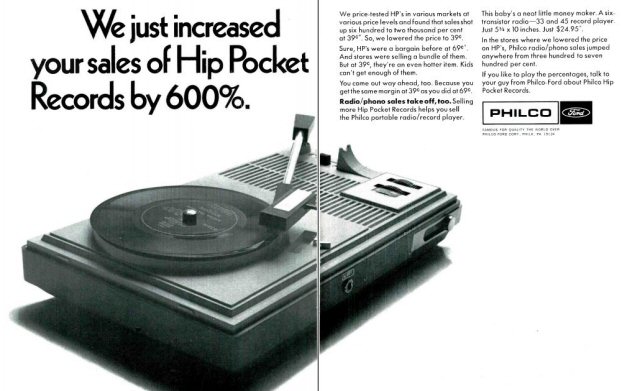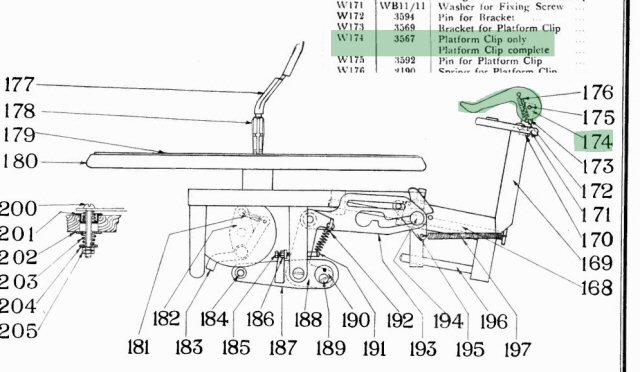Sunday, May 28, 2017
Trend that never started
Two page ad in a 1968 issue of Record World:
 Hip pocket records? I wasn't into pop music, but I was heavily into electronic stuff at the time. Never heard of hip pocket records, never saw one. The player looks like a nice gadget ... radio and 33/45 turntable, highly portable, similar to the Longines Symphonette. The record appears to be SLIGHTLY smaller than a 45, not small enough for a hip pocket. Even if you could fit it in, it would break when you sat down. No advantage or purpose.
The true advantage of 45s was not the small OD but the large ID. The big hole allowed the centerpost of a changer to do all the work of holding and dropping, so you didn't have to fiddle with the extra arm or flopper thingamajig needed on a 33 or 78 changer. You could grab a stack of 45s, slap it down on the changer and start listening.
This "innovation" lost the big hole, so it lost the easy changer action.
= = = = =
Well, I had to get technical. Looked it up. The extra arm thingamajig was called, reasonably enough, the overarm. The flopper thingamajig, which I remembered as fairly common, was apparently a Garrard specialty as seen here, but I can't find a proper name for it.
= = = = =
Later: Still no decisive or universal name for the flopper thingamajig. Closest I can get is this diagram from a Rider manual in 1941. This is an earlier Garrard, not the same as the popular RC-80 series, but the same functional mechanism.
Hip pocket records? I wasn't into pop music, but I was heavily into electronic stuff at the time. Never heard of hip pocket records, never saw one. The player looks like a nice gadget ... radio and 33/45 turntable, highly portable, similar to the Longines Symphonette. The record appears to be SLIGHTLY smaller than a 45, not small enough for a hip pocket. Even if you could fit it in, it would break when you sat down. No advantage or purpose.
The true advantage of 45s was not the small OD but the large ID. The big hole allowed the centerpost of a changer to do all the work of holding and dropping, so you didn't have to fiddle with the extra arm or flopper thingamajig needed on a 33 or 78 changer. You could grab a stack of 45s, slap it down on the changer and start listening.
This "innovation" lost the big hole, so it lost the easy changer action.
= = = = =
Well, I had to get technical. Looked it up. The extra arm thingamajig was called, reasonably enough, the overarm. The flopper thingamajig, which I remembered as fairly common, was apparently a Garrard specialty as seen here, but I can't find a proper name for it.
= = = = =
Later: Still no decisive or universal name for the flopper thingamajig. Closest I can get is this diagram from a Rider manual in 1941. This is an earlier Garrard, not the same as the popular RC-80 series, but the same functional mechanism.
 In this diagram the flopper thingamajig is called the platform clip.
= = = = =
While searching through these sources I noticed that RCA was still making a completely non-electric windup phonograph in the mid-50s. Got me thinking about patient things.
A physical record, especially the big-grooved 78s, is the only advanced technology that can be played with the previous recording technology, namely pen and paper. I used to do it often. Place a ball-point pen through the hole in the record. Stick the pen through something like a spool or a properly-sized box with holes on top and bottom. Now you've got the turntable. Wrap a piece of paper into a cone, scotchtape it in place, and glue a pin or sewing needle through the sharp end of the cone. Now you've got the cartridge. Spin the record with one finger and hold the cartridge with the other hand. Now you've got a phonograph. The paper is flexible enough to let the groove hold the needle, so your cartridge arm doesn't need to be highly precise.
In this diagram the flopper thingamajig is called the platform clip.
= = = = =
While searching through these sources I noticed that RCA was still making a completely non-electric windup phonograph in the mid-50s. Got me thinking about patient things.
A physical record, especially the big-grooved 78s, is the only advanced technology that can be played with the previous recording technology, namely pen and paper. I used to do it often. Place a ball-point pen through the hole in the record. Stick the pen through something like a spool or a properly-sized box with holes on top and bottom. Now you've got the turntable. Wrap a piece of paper into a cone, scotchtape it in place, and glue a pin or sewing needle through the sharp end of the cone. Now you've got the cartridge. Spin the record with one finger and hold the cartridge with the other hand. Now you've got a phonograph. The paper is flexible enough to let the groove hold the needle, so your cartridge arm doesn't need to be highly precise.
 Hip pocket records? I wasn't into pop music, but I was heavily into electronic stuff at the time. Never heard of hip pocket records, never saw one. The player looks like a nice gadget ... radio and 33/45 turntable, highly portable, similar to the Longines Symphonette. The record appears to be SLIGHTLY smaller than a 45, not small enough for a hip pocket. Even if you could fit it in, it would break when you sat down. No advantage or purpose.
The true advantage of 45s was not the small OD but the large ID. The big hole allowed the centerpost of a changer to do all the work of holding and dropping, so you didn't have to fiddle with the extra arm or flopper thingamajig needed on a 33 or 78 changer. You could grab a stack of 45s, slap it down on the changer and start listening.
This "innovation" lost the big hole, so it lost the easy changer action.
= = = = =
Well, I had to get technical. Looked it up. The extra arm thingamajig was called, reasonably enough, the overarm. The flopper thingamajig, which I remembered as fairly common, was apparently a Garrard specialty as seen here, but I can't find a proper name for it.
= = = = =
Later: Still no decisive or universal name for the flopper thingamajig. Closest I can get is this diagram from a Rider manual in 1941. This is an earlier Garrard, not the same as the popular RC-80 series, but the same functional mechanism.
Hip pocket records? I wasn't into pop music, but I was heavily into electronic stuff at the time. Never heard of hip pocket records, never saw one. The player looks like a nice gadget ... radio and 33/45 turntable, highly portable, similar to the Longines Symphonette. The record appears to be SLIGHTLY smaller than a 45, not small enough for a hip pocket. Even if you could fit it in, it would break when you sat down. No advantage or purpose.
The true advantage of 45s was not the small OD but the large ID. The big hole allowed the centerpost of a changer to do all the work of holding and dropping, so you didn't have to fiddle with the extra arm or flopper thingamajig needed on a 33 or 78 changer. You could grab a stack of 45s, slap it down on the changer and start listening.
This "innovation" lost the big hole, so it lost the easy changer action.
= = = = =
Well, I had to get technical. Looked it up. The extra arm thingamajig was called, reasonably enough, the overarm. The flopper thingamajig, which I remembered as fairly common, was apparently a Garrard specialty as seen here, but I can't find a proper name for it.
= = = = =
Later: Still no decisive or universal name for the flopper thingamajig. Closest I can get is this diagram from a Rider manual in 1941. This is an earlier Garrard, not the same as the popular RC-80 series, but the same functional mechanism.
 In this diagram the flopper thingamajig is called the platform clip.
= = = = =
While searching through these sources I noticed that RCA was still making a completely non-electric windup phonograph in the mid-50s. Got me thinking about patient things.
A physical record, especially the big-grooved 78s, is the only advanced technology that can be played with the previous recording technology, namely pen and paper. I used to do it often. Place a ball-point pen through the hole in the record. Stick the pen through something like a spool or a properly-sized box with holes on top and bottom. Now you've got the turntable. Wrap a piece of paper into a cone, scotchtape it in place, and glue a pin or sewing needle through the sharp end of the cone. Now you've got the cartridge. Spin the record with one finger and hold the cartridge with the other hand. Now you've got a phonograph. The paper is flexible enough to let the groove hold the needle, so your cartridge arm doesn't need to be highly precise.
In this diagram the flopper thingamajig is called the platform clip.
= = = = =
While searching through these sources I noticed that RCA was still making a completely non-electric windup phonograph in the mid-50s. Got me thinking about patient things.
A physical record, especially the big-grooved 78s, is the only advanced technology that can be played with the previous recording technology, namely pen and paper. I used to do it often. Place a ball-point pen through the hole in the record. Stick the pen through something like a spool or a properly-sized box with holes on top and bottom. Now you've got the turntable. Wrap a piece of paper into a cone, scotchtape it in place, and glue a pin or sewing needle through the sharp end of the cone. Now you've got the cartridge. Spin the record with one finger and hold the cartridge with the other hand. Now you've got a phonograph. The paper is flexible enough to let the groove hold the needle, so your cartridge arm doesn't need to be highly precise.Labels: Alternate universe, Patient things
